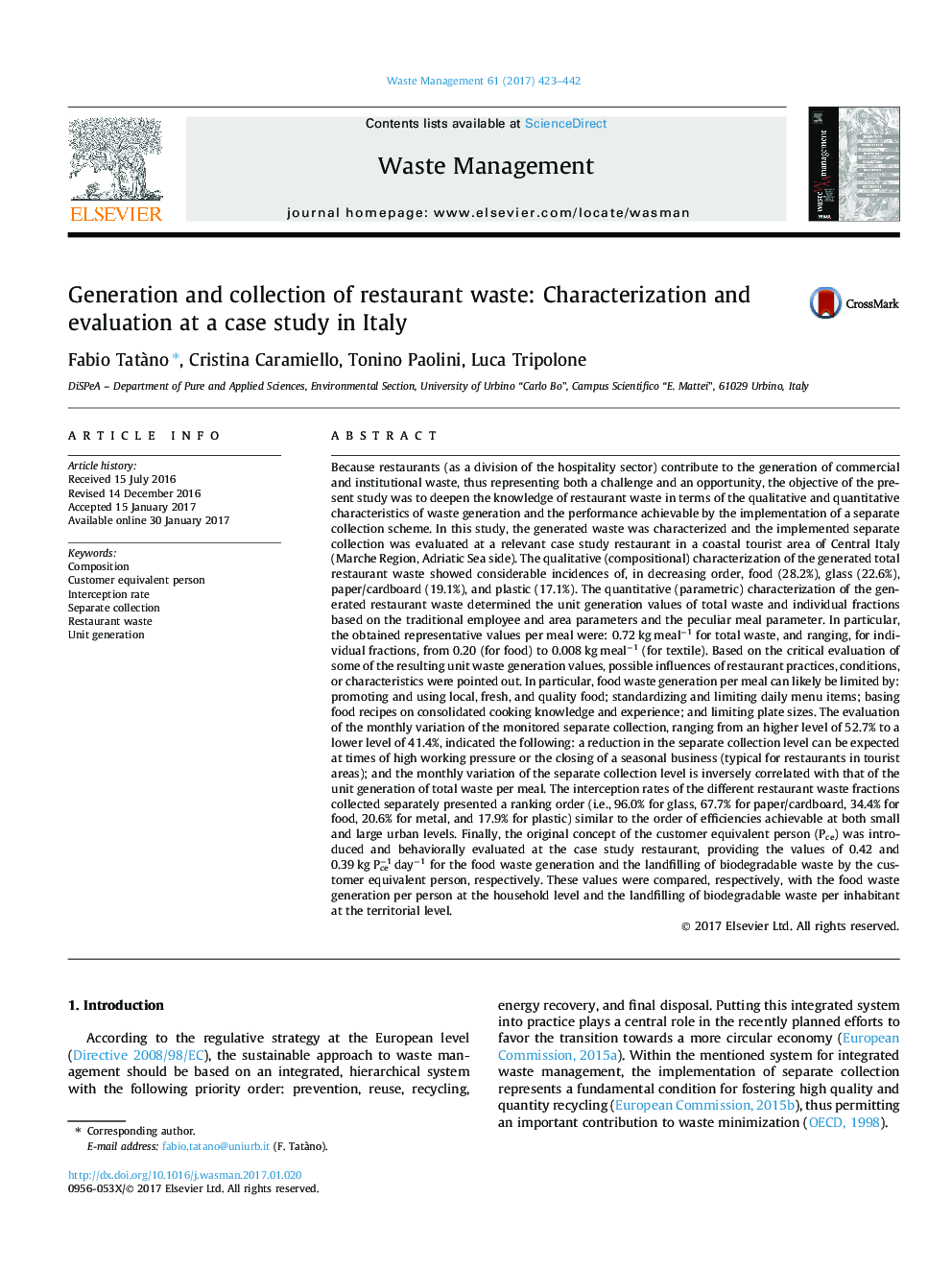| کد مقاله | کد نشریه | سال انتشار | مقاله انگلیسی | نسخه تمام متن |
|---|---|---|---|---|
| 5756979 | 1622625 | 2017 | 20 صفحه PDF | دانلود رایگان |
- Generation and separate collection of restaurant waste were characterized and evaluated.
- Unit generation values of waste (total, fractions) were derived per meal, employee, and area.
- Relevant influences of restaurant practices or characteristics were noted.
- Separate collection levels may be lower at times of working pressure or seasonal closing.
- The customer equivalent person concept was introduced and behaviorally evaluated.
Because restaurants (as a division of the hospitality sector) contribute to the generation of commercial and institutional waste, thus representing both a challenge and an opportunity, the objective of the present study was to deepen the knowledge of restaurant waste in terms of the qualitative and quantitative characteristics of waste generation and the performance achievable by the implementation of a separate collection scheme. In this study, the generated waste was characterized and the implemented separate collection was evaluated at a relevant case study restaurant in a coastal tourist area of Central Italy (Marche Region, Adriatic Sea side). The qualitative (compositional) characterization of the generated total restaurant waste showed considerable incidences of, in decreasing order, food (28.2%), glass (22.6%), paper/cardboard (19.1%), and plastic (17.1%). The quantitative (parametric) characterization of the generated restaurant waste determined the unit generation values of total waste and individual fractions based on the traditional employee and area parameters and the peculiar meal parameter. In particular, the obtained representative values per meal were: 0.72 kg mealâ1 for total waste, and ranging, for individual fractions, from 0.20 (for food) to 0.008 kg mealâ1 (for textile). Based on the critical evaluation of some of the resulting unit waste generation values, possible influences of restaurant practices, conditions, or characteristics were pointed out. In particular, food waste generation per meal can likely be limited by: promoting and using local, fresh, and quality food; standardizing and limiting daily menu items; basing food recipes on consolidated cooking knowledge and experience; and limiting plate sizes. The evaluation of the monthly variation of the monitored separate collection, ranging from an higher level of 52.7% to a lower level of 41.4%, indicated the following: a reduction in the separate collection level can be expected at times of high working pressure or the closing of a seasonal business (typical for restaurants in tourist areas); and the monthly variation of the separate collection level is inversely correlated with that of the unit generation of total waste per meal. The interception rates of the different restaurant waste fractions collected separately presented a ranking order (i.e., 96.0% for glass, 67.7% for paper/cardboard, 34.4% for food, 20.6% for metal, and 17.9% for plastic) similar to the order of efficiencies achievable at both small and large urban levels. Finally, the original concept of the customer equivalent person (Pce) was introduced and behaviorally evaluated at the case study restaurant, providing the values of 0.42 and 0.39 kg Pceâ1 dayâ1 for the food waste generation and the landfilling of biodegradable waste by the customer equivalent person, respectively. These values were compared, respectively, with the food waste generation per person at the household level and the landfilling of biodegradable waste per inhabitant at the territorial level.
Journal: Waste Management - Volume 61, March 2017, Pages 423-442
